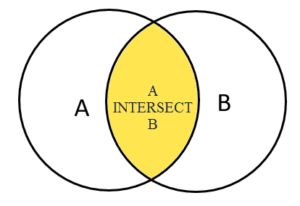PostgreSQL INTERSECT Operator
Summary: in this tutorial, you will learn how to use the PostgreSQL INTERSECT operator to combine result sets of two or more queries.
Introduction to PostgreSQL INTERSECT operator
Like the UNION and EXCEPT operators, the PostgreSQL INTERSECT operator combines result sets of two SELECT statements into a single result set. The INTERSECT operator returns a result set containing rows available in both results sets.
Here is the basic syntax of the INTERSECT operator:
SELECT select_list
FROM A
INTERSECT
SELECT select_list
FROM B;To use the INTERSECT operator, the columns that appear in the SELECT statements must follow these rules:
- The number of columns and their order in queries must be the same.
- The data types of the columns in the queries must be compatible.
The following diagram illustrates how the INTERSECT operator combines the result sets A and B. The final result set is represented by the yellow area where circle A intersects circle B.

PostgreSQL INTERSECT with ORDER BY clause
If you want to sort the result set returned by the INTERSECT operator, you place the ORDER BY after the final query:
SELECT select_list
FROM A
INTERSECT
SELECT select_list
FROM B
ORDER BY sort_expression;Setting up sample tables
We’ll create two tables top_rated_films and most_popular_films for demonstration:
CREATE TABLE top_rated_films(
title VARCHAR NOT NULL,
release_year SMALLINT
);
CREATE TABLE most_popular_films(
title VARCHAR NOT NULL,
release_year SMALLINT
);
INSERT INTO top_rated_films(title, release_year)
VALUES
('The Shawshank Redemption', 1994),
('The Godfather', 1972),
('The Dark Knight', 2008),
('12 Angry Men', 1957);
INSERT INTO most_popular_films(title, release_year)
VALUES
('An American Pickle', 2020),
('The Godfather', 1972),
('The Dark Knight', 2008),
('Greyhound', 2020);
SELECT * FROM top_rated_films;
SELECT * FROM most_popular_films;The contents of the top_rated_films table:
title | release_year
--------------------------+--------------
The Shawshank Redemption | 1994
The Godfather | 1972
The Dark Knight | 2008
12 Angry Men | 1957
(4 rows)The contents of the most_popular_films table:
title | release_year
--------------------+--------------
An American Pickle | 2020
The Godfather | 1972
The Dark Knight | 2008
Greyhound | 2020
(4 rows)PostgreSQL INTERSECT operator examples
Let’s explore some examples of using the INTERSECT operator.
1) Basic INTERSECT operator example
The following example uses the INTERSECT operator to retrieve the popular films that are also top-rated:
SELECT *
FROM most_popular_films
INTERSECT
SELECT *
FROM top_rated_films;Output:
title | release_year
-----------------+--------------
The Godfather | 1972
The Dark Knight | 2008
(2 rows)The result set returns one film that appears on both tables.
2) Using the INTERSECT operator with ORDER BY clause example
The following statement uses the INTERSECT operator to find the most popular films which are also the top-rated films and sort the films by release year:
SELECT *
FROM most_popular_films
INTERSECT
SELECT *
FROM top_rated_films
ORDER BY release_year;Output:
title | release_year
-----------------+--------------
The Godfather | 1972
The Dark Knight | 2008
(2 rows)Summary
- Use the PostgreSQL
INTERSECToperator to combine two result sets and return a single result set containing rows appearing in both. - Place the
ORDER BYclause after the second query to sort the rows in the result set returned by theINTERSECToperator.